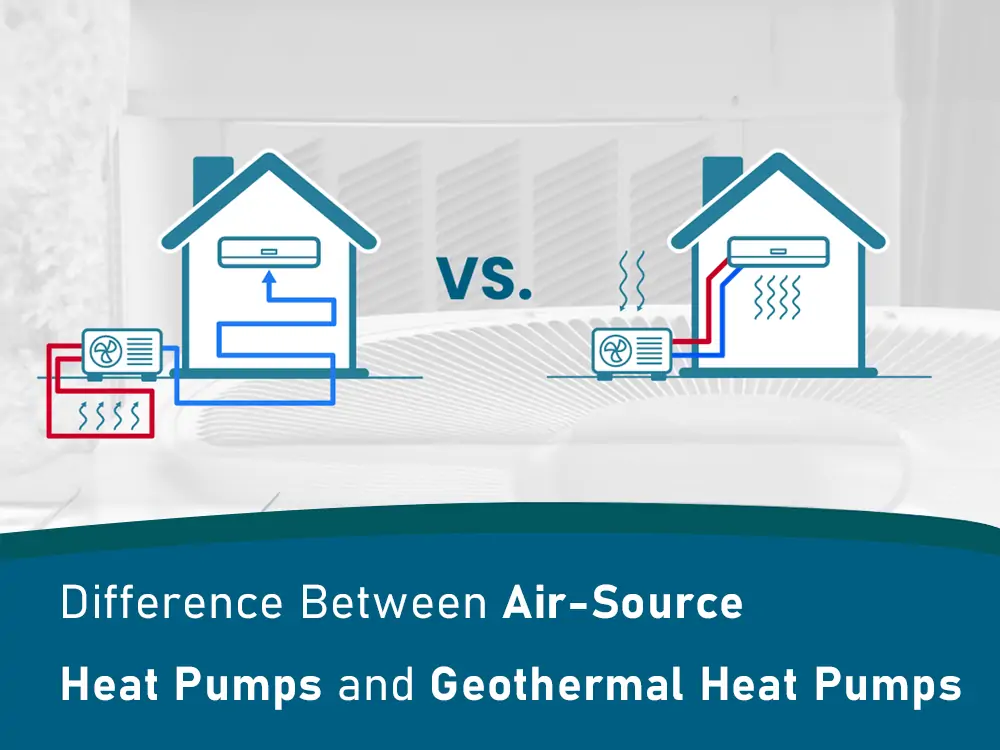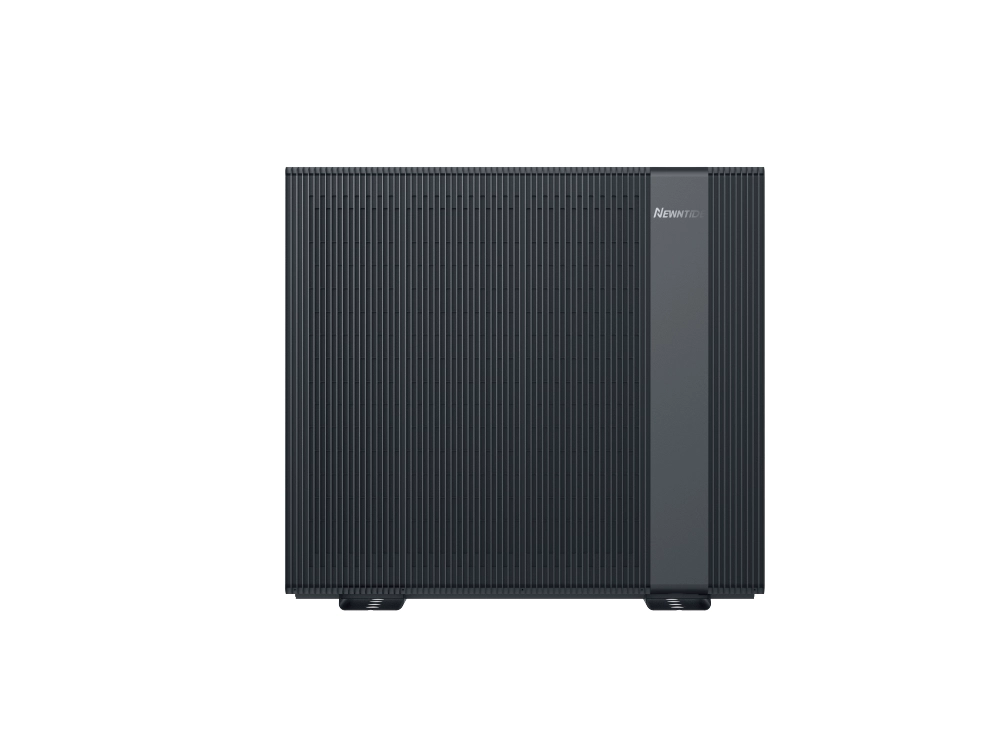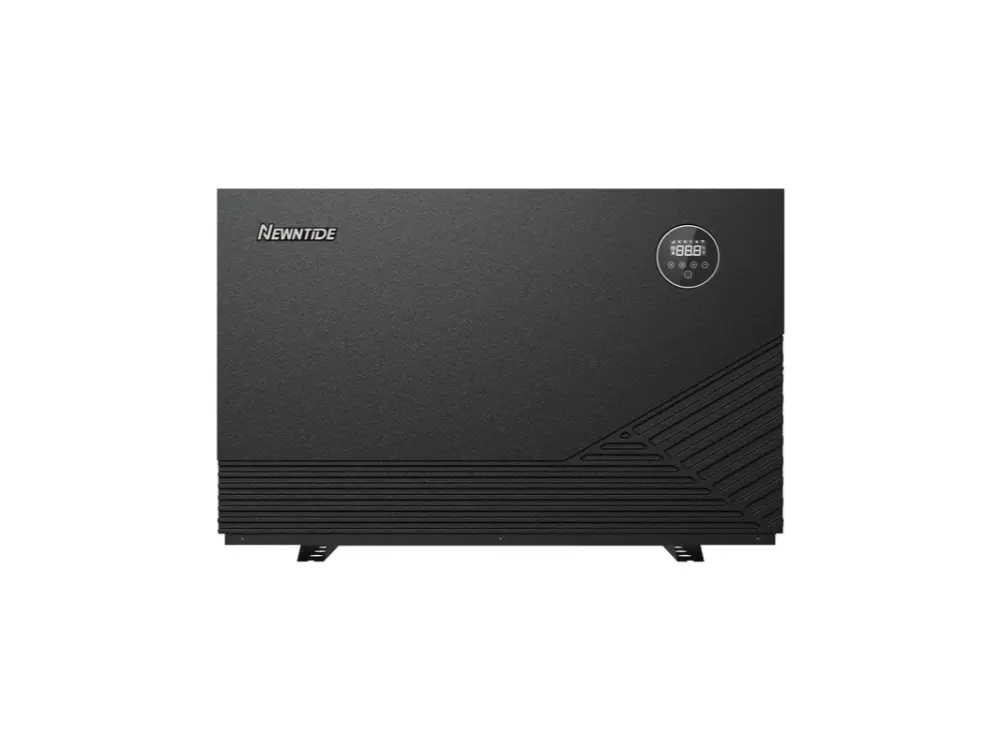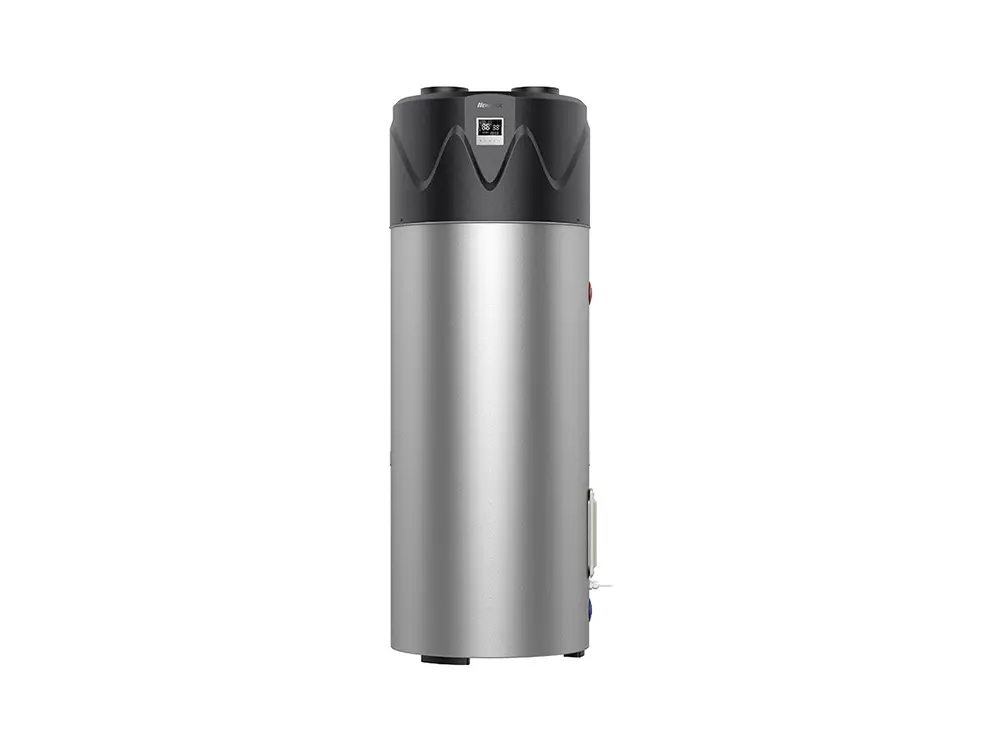
Introduction
As you can see, heat pumps are among the chief variants of HVAC systems. They can provide both cooling and heating throughout summers and winters, respectively.
You’ll find variations in available heat pumps. Not every heat pump type may be suitable for you based on your necessities.
Here, we’ll compare an air-source heat pump vs geothermal heat pump. These are the two principal heat pump types you’ll find today.
You’ll learn the noteworthy differences between these two heat pump types. You’ll also learn about the meanings, functions, advantages, and disadvantages of both heat pump variants.
Lastly, we’ll outline some significant considerations that will help you to opt for one.
Understanding Heat Pumps
Heat pumps are mechanical devices that transport heat from one location to another. They are powered by electricity and utilize a refrigeration cycle to transport heat.
Distinct from conventional heating systems that burn fossil fuels, heat pumps don’t generate heat energy. They provide cooling and heating, making them an all-round option for homeowners.
During summer, the device draws heat energy from the indoor air and ejects it outdoors. That keeps your home comfortable and cool even on hot, blistering days.
In colder weather, a heat pump is operative in reverse. It pumps heat energy from the outside air or the ground (reliant on the type). It then transfers the heat indoors.
This process is energy-efficient because the device moves heat energy instead of creating it. Besides cooling and heating, it also heats water, especially for residential use, when correctly configured.
Geothermal vs. Air-source — What’s the difference?
As stated before, there are two chief types of heat pumps. These include ground-source heat pumps (GSHPs) and air-source heat pumps (ASHPs).
Both heat pump variants are clean and energy-saving technologies. Yet there are some imperative differences between them that you must know.
| Heat pump variant | Ground-source or Geothermal heat pump | Air-source heat pump |
| Cost | Between $10000 to $30000 | Between $3500 to $20000 |
| Space requirements | More space needed | Less space needed |
| Efficiency | More efficient | Generally, less efficient |
| Lifespan | Up to 25 years for the indoor units; over 50 years for the underground ground loop | Between 15 to 25 years |
| Incentives | Available | Available |
Let’s delve into the differences between the two heat pump variants in greater detail.
Cost
Overall, the costs of installing a GSHP are higher than those of an ASHP.
The cause is the added exterior components needed and the installation alone for GSHPs. Thus, contractors dig into your property to install the ground loop, which requires heavy machinery. ASHP installations are less exhaustive of labor and need less time.
Thus, the expected costs of installing a GSHP are between $10000 to $30000. That can sometimes reach $50000, depending on your property.
Conversely, ASHPs cost between $3500 to $6000 for every indoor head for ductless systems. The cost ranges between $12000 to $20000 for central ducted systems.
Space requirements
Space requirement is a critical factor to consider when choosing a heat pump. GSHPs necessitate more space than ASHPs.
For ASHPs, each part lies above the ground and is laid alongside your home or building. That’s the reason they require less space.
In contrast, GSHPs require digging into your land to install the ground loop elements. Plus, they have added outdoor elements. Furthermore, installing GSHPs may require a few changes to your property’s landscape.
Thus, air-source heat pumps fit homes without large yards.
Efficiency
As stated before, heat pumps are classified as clean and efficient technology. When comparing GSHPs and ASHPs for efficiency, GSHPs are the winner.
Air-source heat pumps can reach heating efficiencies of about 400%. Thus, for every 100 kW (kilowatts) of electricity consumed, they provide 400 kW of heat energy.
GSHPs can provide efficiencies of up to 600%. They can further lessen energy usage by 25-50% compared to air-source heat pumps.
Also, GSHPs save up to 70% on heating bills compared to fossil-fuel-based systems. For air-source heat pumps, this figure is up to 60%. Yet, the efficiency of ASHPs can lessen in extremely cold weather conditions.
Lifespan
Geothermal heat pumps usually have longer lifespans than air-source heat pumps. A GSHP’s main parts lie inside your home or underground.
ASHPs are more exposed to weather and outdoor conditions and degrade more quickly.
The usual lifespan of most ASHPs is between 15 to 25 years. Meanwhile, GSHPs can carry on for 25 years for indoor units. Note that a GSHP’s ground loop (lying underground) can persist for over 50 years.
Incentives
You can acquire tax credits or rebates when installing GSHPs or ASHPs. That can help in lessening the upfront costs.
Let’s consider the USA. You can gain a tax credit for 30% of your eligible heat pump costs here. It can be right up to $2000 yearly from 2023-2033 via “Energy Efficiency Home Improvement Credit”. It’s made possible according to the Inflation Reduction Act (IRA) law. This law also covers state-administered rebates of as much as $8,000 for heat pumps.
You may also get higher incentives if you also install a geothermal system. Such householders who install it are qualified for the ITC (Investment Tax Credit). You can claim 30% of GSHP installation expenses as a federal tax credit. It’s for setting up such a system between 2022 and 2032.
What is an air-source heat pump?
As stated before, an ASHP is a mechanical device. It transports heat energy from the outside air to your home’s inside or vice versa.
In winter, it draws heat energy from the outside air and warms up your home. Note that the cold air outside still possesses heat energy, which the device uses. The operation is reversed in summer as it pulls out heat from your home. It then leads to cooling in your home.
ASHPs can be ductless or ducted. On top of cooling and heating, they can further lead to generate hot water.
There exist two main variants of ASHPs. Air-to-air heat pumps only warm or cool your home and don’t provide hot water.
Air-to-water heat pumps capture heat from the outside air and employ it for two purposes. It provides heating and hot water inside your home.
How does an air-source heat pump work?
We earlier described the two ASHP types. Both air-to-air and air-to-water variants draw heat energy from the outdoor air. It’s made possible via an outdoor unit that performs like a refrigerator, yet in reverse.
Both ASHP types have similar modes of operation except for a few differences.
Let’s discuss the operation of both ASHP variants:
Working of air-to-air heat pump
The vital components of such heat pumps are refrigerants and compressors.
In heating mode, a cool liquid refrigerant draws heat energy from the outdoor unit. The refrigerant then turns into a cold gas.
Afterward, a compressor squeezes the cold gas. That elevates the pressure and temperature of the cold gas.
Subsequently, the “hot” gas proceeds through a condenser coil. That releases the heat energy into the home’s heating system.
Afterward, the refrigerant cools off and turns back into a liquid state. Thus, it’s ready to commence the cycle again.
This process transports heat from the outside air into your home, even during cold days. The operation can further be reversed to cool the inside air.
Working of air-to-water heat pump
An air-to-water heat pump has a similar mode of operation. But it heats water instead of heating air.
That allows the device to provide space heating via radiators or underfloor heating. It also provides hot tap water to your home. Thus, it can meet your home’s heating needs entirely.
An air-to-water heat pump doesn’t have a reverse cooling function like an air-to-air heat pump.
Advantages and disadvantages of air-source heat pumps
Let’s grasp some noteworthy upsides and downsides of air-source heat pumps. These are:
Advantages
- Air-source heat pumps can be installed practically in any place. They are ideal if you have a small yard or reside in a city.
- ASHPs are economical and easier to install than their geothermal counterparts. That’s why many homeowners pick ASHPs.
- An ASHP is less difficult to maintain than a GSHP. It’s because their repairs and maintenance are more simple and less expensive. Plus, they don’t have underground elements.
- ASHPs don’t need any digging in your yard. Plus, they are much more flexible and customizable where you are installing them.
Disadvantages
- Air-source heat pumps are indeed highly efficient and reliable. But, they fall short of geothermal counterparts in this area.
- Air-source heat pumps can last about 15-25 years. But it’s not quite as long as their geothermal counterparts.
- ASHPs rely on the heat energy from the outside air in the winter. Thus, they may struggle in excessively cold weather situations.
- ASHPs may not be very effective in homes that aren’t fully insulated.
What is a geothermal heat pump?
A geothermal heat pump is commonly referred to as an earth-coupled or ground-source heat pump. It uses the earth’s near-uniform temperature (around 55 °F), some feet underneath the surface. Such a temperature is sufficient for a GSHP to cool and heat your home. It can also render hot water to buildings.
Such a heat pump transports heat from the ground into a building in winter. During the summers, this process is reversed.
You see that, especially during winter, the ground temperature is persistently warmer than the surrounding air. That allows a GSHP to provide reliable heating during cold months.
GSHPs are one of the most efficient cooling, heating and water heating technologies.
How does a geothermal heat pump work?
A ground-source heat pump is made of three main parts:
- Heat exchanger or ground loop: A horizontal or vertical loop of pipes that’s installed underground
- Heat pump unit: An indoor heat pump unit that’s joined to the ground loop
- Distribution system: This system provides comfortable interior temperatures
Operation
The ground loop transports heat between the ground and the surface. It’s made possible via a water-based fluid that flows through the pipes.
Heat is transported to the heat exchanger in warmer months from the building’s warm air. It then moves into the fluid. As heat energy moves through the pipes, it disperses to the soil, rocks and groundwater.
In winter, the heat energy in the warm ground increases the fluid’s temperature. The fluid then transports this heat energy to the heat pump. In consequence, the air within the building gets warm. It implies that the operation is reversed in winter compared to summer.
Advantages and disadvantages of geothermal heat pumps
Geothermal heat pumps have numerous advantages and disadvantages. Here are some noteworthy ones:
Advantages
- GSHPs are more efficient and consistent in function than ASHPs. It’s because the temperature underground is more persistent than the air. The air temperature can differ a great deal, especially in winter.
- GSHPs are potentially more long-lasting than ASHPs. It’s because the underground parts of GSHPs survive longer.
- GSHPs are not reliant on external air. Thus, it increases their efficiency in extremely cold weather.
- As they are installed underground, GSHPs make less noise than ASHPs.
Disadvantages
- Geothermal heat pumps are very pricey. They can be expensed up to double that of air-source heat pumps. The cause is the added labor and materials needed for installation. A valuable geothermal system could be priced up to $45000 or more.
- Such heat pumps need digging and drilling in your lawn. It can be damaging to your landscaping and grass.
- GSHPs need more outdoor space for installation than ASHPs.
- A GSHP’s efficiency can be affected by the property’s soil type. For instance, sandy soil may slightly diminish its efficiency.
Which should I choose?
You can pertain to the following table to aid you in selecting a GSHP or an ASHP:
| You should select a ground-source heat pump if: | You should select an air-source heat pump if: |
| You have a large outdoor space to install the needed underground components. | You don’t have sufficient outdoor space for a GSHP. Or you don’t want to break your yard. |
| You require a topmost energy-efficient heat pump and are prepared to make the big investment. | You want a heat pump’s energy efficiency and comfort but at a lower price. |
| You reside in a very cold climate and want a highly efficient device. It should function at its best even in very low temperatures (below -13°C). | You live in a location that doesn’t experience extremely low temperatures frequently (below -13°C). |
| You want a heat pump with the longest lifetime, regardless of price. | You want all the benefits a heat pump can provide without many inconveniences. |
Conclusion
You must have gained sufficient insight into comparing GSHPs and ASHPs by now.
We elaborated on the functioning, pros, and cons of both heat pump variants. We also inspected the differences between GSHPs and ASHPs and what you should select.
By installing a GSHP or ASHP, you can save on your cooling and heating expenses. Nevertheless, that’s primarily dependent on your budget, home or building’s requirements and priorities.



